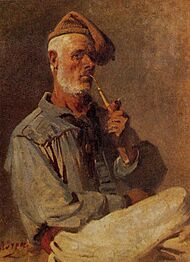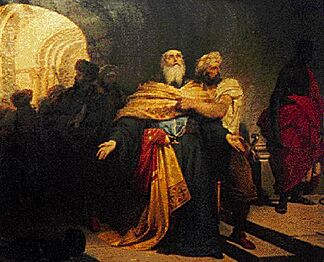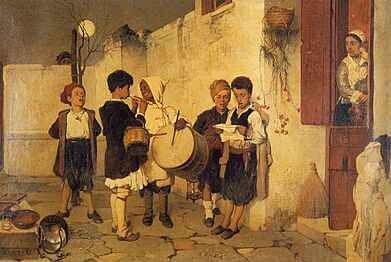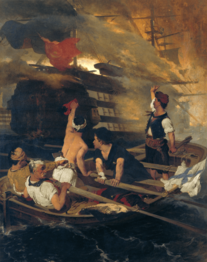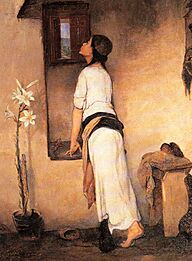Nikiforos Lytras facts for kids
Quick facts for kids
Nikiforos Lytras
|
|
|---|---|
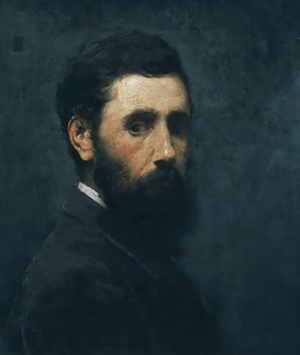
Νikiforos Lytras, self-portrait
|
|
| Born | 1832 Tinos, Greece
|
| Died | 13 June 1904 Athens, Greece
|
| Education | School of Arts, Athens (1850–60) Royal Academy of Fine Arts, Munich |
| Known for | Painter and faculty member |
| Movement | Orientalist Munich School Genre art |
| Spouse(s) | Irene Kyriakidi |
Nikiforos Lytras (born 1832, died 1904) was a famous Greek painter. He was born on the island of Tinos in Greece. He learned to paint in Athens at the School of Arts. In 1860, he earned a special scholarship. This allowed him to study at the Royal Academy of Fine Arts in Munich, Germany.
After finishing his studies, he became a professor. He taught at the School of Arts in Athens starting in 1866. He kept this job for the rest of his life. Lytras followed the style of the Munich School of art. He loved painting scenes of everyday life and portraits of people. His most famous portrait was of the royal couple, Otto and Amalia.
Contents
Nikiforos Lytras' Early Life
Nikiforos Lytras was the son of a well-known marble sculptor. In 1850, when he was 18 years old, he moved to Athens. He went there to study at the School of Arts. He learned painting from teachers like Ludwig Thiersch. After he finished his studies in 1856, he started teaching a basic writing class.
Studying Art in Munich
In 1860, Lytras received a scholarship from the Greek government. This allowed him to go to Munich, Germany. He studied at the Royal Academy of Fine Arts. There, he was accepted into the classes of a famous artist named Karl von Piloty.
In 1862, King Otto of Greece was sent away from the country. Because of this, Lytras' scholarship stopped. But the Greek ambassador in Vienna, Simon Sinas, paid for his studies instead. In 1865, before returning to Greece, Lytras met another artist, Nikolaos Gyzis. They visited many art museums together in Munich.
Becoming a Professor
After returning to Athens, Lytras became a professor. He taught painting at the Athens School of Fine Arts. He taught there for 38 years until he passed away. Many students learned from him, including Spyridon Vikatos.
Travels and Family Life
From 1873, Lytras traveled for four years. He visited places like Smyrna and Asia Minor, Munich, and Egypt. He traveled with his friend Nikolaos Gyzis. During these trips, he created many paintings that showed scenes from the Middle East.
In 1879, he married Irene Kyriakidi. She was the daughter of a merchant from Smyrna. They had six children together. His son, Nikolaos Lytras, also became a painter. He studied in Munich and later led the Athens School of Art. Nikiforos Lytras died in 1904 at age 72. It is thought that chemicals in his paints made him sick. After he died, Georgios Jakobides took his place at the Athens School of Fine Arts.
Lytras' Artistic Style
Lytras' paintings changed over time. When he was a student of Piloty, he focused on history painting. He painted scenes inspired by Greek Mythology and Greek history. After he came back to Greece, he started painting portraits. He also painted scenes from everyday life. He once wrote that painters should focus on subjects that "move, delight, and educate the people."
Influences and Exhibitions
His trips to Asia Minor and Egypt added new ideas to his art. He painted many scenes with people and their ways of life from those regions. Later in his life, he painted about aging, loneliness, and the fear of death.
Lytras was one of the most famous painters in Athens. His art was shown in many exhibitions. These included shows at the Zappeion in Athens. His work was also displayed in Paris (in 1855, 1867, 1878, 1889, and 1900) and in Vienna (1873). He was the official portrait painter in Athens. He painted many important people from the upper class of his time.
His teaching at the Athens School of Fine Arts also helped art grow in Greece. He followed the style of Academic Realism. He was not influenced by Impressionism. But he still made a big mark on Greek art history. In 1903, he received a special award called the Golden Cross of the Order of the Redeemer. After he died, some of his paintings were shown in Munich in 1909. In 1933, an exhibition in Athens showed 186 of Lytras' paintings.
Images for kids
-
Antigone in front of dead Polynikes (1865), National Gallery of Athens.
-
Execution of Patriarch Gregory V of Constantinople
-
The blowing up of Nasuh Ali Pasha's flagship by Kanaris



